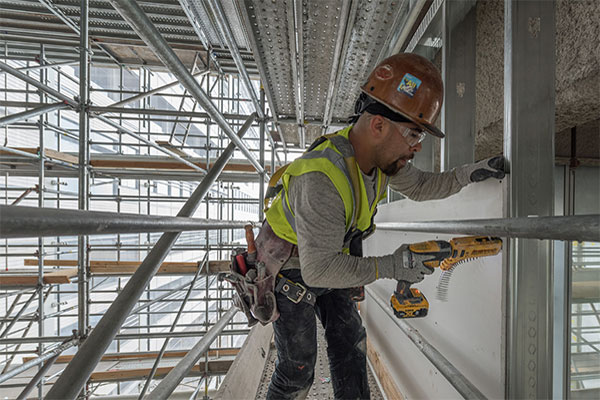Drywall Installment Made Easy: Tips for Perfect Outcomes
Drywall installment is frequently perceived as an overwhelming job, yet with the right strategy and expertise, it can end up being a workable venture. Grasping methods for cutting, hanging, and ending up drywall can dramatically affect the end result.
Picking the Right Materials
Selecting the appropriate materials for drywall installment is crucial to accomplishing a durable and cosmetically pleasing coating. drywall fort worth. The primary part, drywall sheets, typically can be found in different thicknesses, with 1/2-inch sheets being common for indoor walls. For locations requiring added moisture resistance, such as kitchens or restrooms, consider making use of green board or cement board, which are specifically created to stand up to moisture

Additionally, choosing the right bolts-- either nails or screws-- is essential for protecting the drywall to the framework. Drywall screws are generally preferred for their holding power and minimized danger of standing out. Think about the finishing touches such as guide and paint, which not only improve the look but additionally safeguard the drywall from wetness and wear.
Preparing the Setup Location
Before beginning the drywall setup procedure, it is vital to prepare the installment area thoroughly. A tidy workspace lessens the danger of damage to existing things and permits for reliable movement throughout setup.
Next, evaluate the wall surfaces and ceiling for any imperfections, such as splits, openings, or mold and mildew. Address these problems beforehand; spot any kind of damages and enable enough time for fixings to dry. Additionally, make sure that electrical outlets, switches, and pipes are correctly placed and made up, as this will affect drywall positioning.
Think about the environmental conditions also. A steady temperature and moisture level are vital for optimal adhesion and efficiency of the drywall materials. Use a dehumidifier or heater to develop appropriate problems. if required.
Trimming and Hanging Drywall
The secret to effective drywall setup hinges on the accurate cutting and dangling of the panels. Begin by determining the room accurately, thinking about any type of obstructions such as electric outlets or home windows. Make use of a straight edge and an energy knife to score the drywall along your dimensions, then snap it along the racked up line for a clean break. For even more complex cuts, such as around electrical outlets, a drywall saw can be made use of for precision.

Constantly work from the top down and delegated right, ensuring that you keep a staggered pattern to improve security. Properly hanging the drywall sets the structure for a smooth finish, inevitably causing premium lead to your drywall job.
Insulation and Mudding Strategies
While proper cutting and dangling of drywall sets the phase, the following important action includes mastering taping and mudding techniques to ensure a seamless surface. Taping is important for reinforcing joints and preventing cracks; it includes embedding tape right into the applied joint compound (mud) Begin with a high quality fiberglass or paper tape, applying the tape over the joint and pressing it right into the wet mud using a taping blade, guaranteeing no air bubbles stay.
Once the tape is in place, use a thin layer of joint compound over the tape, feathering the sides to create a smooth transition to the drywall surface. Permit this layer to dry entirely prior to sanding it lightly to eliminate flaws. Repeat this process, using additional layers of mud as essential-- typically two to 3 layers-- while slowly widening the application location with each layer to achieve a smooth look.
After official site the final layer dries out, sand the surface with a fine-grit sandpaper till smooth. sheetrock repair fort worth. Remember to put on a mask during sanding to avoid inhaling dust fragments. Grasping these taping and mudding methods is crucial for accomplishing a professional-quality coating in your drywall setup
Finishing Touches for Perfection
Achieving a flawless drywall setup surpasses taping and mudding; it culminates in the ending up touches that elevate the general look. These last actions are critical in guaranteeing a professional-grade coating that boosts the aesthetics of your area.
Begin by sanding the dried joint compound to develop a smooth surface area. Use a fine-grit sandpaper and a sanding block or pole sander for optimum control. Pay certain interest to sides and edges, as these locations have a tendency to call for more thorough job. After sanding, wipe down the walls with a moist cloth to remove any kind of dirt bits, guaranteeing a clean surface area for painting.
Following, use a primer especially designed for drywall. This action is crucial, as it helps secure the joint compound and supplies an uniform base for the overcoat. Once the guide dries, examine for any imperfections, and repair these details as needed.
Verdict
Finally, successful drywall installment depends upon the mindful selection of materials, comprehensive prep work of the installation location, and specific implementation of reducing and hanging strategies. Mastery of taping and mudding procedures is necessary for attaining a smooth surface. In addition, focus to ending up touches, consisting of priming and touch-ups, ensures a Learn More professional-grade result. By adhering to these standards, the top quality of workmanship can be substantially boosted, adding to the total visual and performance of the space.
Drywall setup is frequently regarded as a complicated job, yet with the best technique and understanding, it can become a workable undertaking.Picking the suitable products for drywall installment is important to accomplishing a long lasting and cosmetically pleasing finish.Prior to beginning the drywall setup procedure, it is essential to prepare the installation location thoroughly. Understanding these taping and mudding techniques is critical for achieving a professional-quality finish in your drywall installation.
In final thought, effective drywall installation pivots on the careful option of materials, comprehensive prep work of the setup location, and exact implementation of cutting and hanging methods.